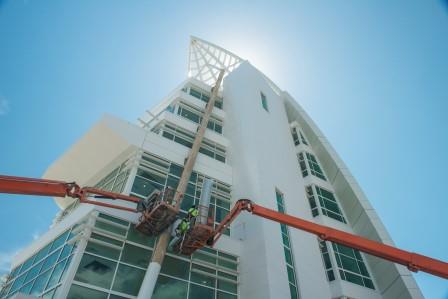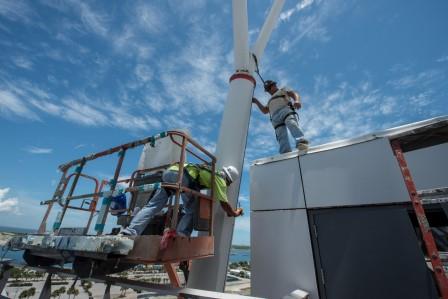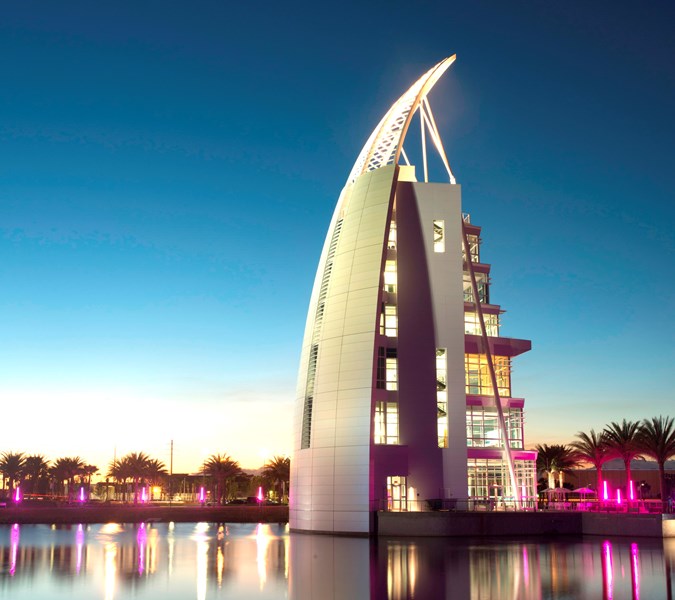It’s a bird! It’s a plane! It’s…a tower?
When Port Canaveral’s new Exploration Tower opened in November 2013, it gave the historic Central Florida spot a new icon. Over the years, the port has been home to Carnival, Disney, and Royal Caribbean cruise lines; it’s been a central site for commercial shipping; and it’s been a part of the American space program.
It makes sense, then, that the new Exploration Tower would remind onlookers of the myriad parts of the port’s history. It’s reminiscent of a sail, ship, and shuttle. It was quite the triple crown for companies involved in the creation of the new tower, including coatings applicator Linetec and the manufacturer of the color-changing coatings.
Red, Gold, and Green
The seven-story visitor center includes an observation area, gift shops, and exhibits. To get the job done, it took Linetec’s factory paint line, which included “a plethora of Linetec employees…from the project manager, to engineering, to plant management and supervisors, to all the production workers that had a hand in getting this material painted and properly packaged for shipment to the jobsite,” explained Tony Pupp, national accounts manager for Linetec. Because the project was for a Central Florida site, the right coatings system needed to be chosen. In fact, “the finish must withstand Florida’s hurricane wind speeds, unrelenting sun, and salt spray,” according to a Valspar overview. Therefore, the Kameleon Polyvinylidene fluoride (PVDF) Fluropon three-coat system — primer, basecoat, and topcoat — was chosen.
“It is the first use of Valspar’s Kameleon Color mica coating as a spray application,” Pupp said. Linetec’s Paint Plant Manager Paul Bratz seconded the sentiment in the Linetec case history report: “No one has sprayed this before, but our knowledgeable staff was up to the challenge. There was some trial and error during the process. It was critical that each  paint run maintained the same parameters. The spray conditions, paint prep, and application consistency of the paint itself were all critical. The slightest change could alter the look of the paint.”
paint run maintained the same parameters. The spray conditions, paint prep, and application consistency of the paint itself were all critical. The slightest change could alter the look of the paint.”
Even though the application portion of the project took place inside the facility where environmental variables could be set at a minimum, it was still crucial for the Linetec crew to maintain as much consistency as possible on each panel. It started with a consistent paint. “Valspar prepared the special mica technology paint all at one time with excellent consistency, taking out the variable of multiple paint batches,” Bratz continued in the Linetec case history report.
Each of the 42 UNA-CLAD pre-fabricated units contained several metal panels from Firestone Metal Products. The panels varied in size, but they were generally 38 inches by 68 inches (97 cm x 173 cm). They were shipped to the Linetec facility by Firestone, which was Linetec’s direct customer on this project. “We coated the panels, packaged them, and then they set up which trucking they wanted to use down to the jobsite,” said Pupp. Everything was coordinated down to the t, but first, the panels would have to be coated!
Coatings Club
To start the application process, all 23,000 square feet (2,137 m²) of the aluminum surfaces needed to be prepped. “Linetec properly pretreated the aluminum to remove any residual fabricating oils and create a bond for the paint coating to stick to,” Pupp said. Then, wearing 3M respirators, protective paint suits, Ground Hog gloves, and electrostatic dissipating (ESD) shoes, the line crew could move the panels into the coating process.
 Each panel received the full system in two passes. First, they applied the primer and the basecoat. Then they applied the topcoat. The coatings were applied at an average overall thickness of 2.35 mils (60 microns) total: the primer was applied at 0.2–0.4 mils (5–10 microns), the basecoat was applied at 1.0–1.3 mils (25–33 microns), and the topcoat was applied at 0.8–1.0 mils (20–25 microns). After each pass was applied, the paint line sent the panels through the cure oven to dry. It took 10–15 minutes for the coatings to cure in a 450° F (232° C) peak oven.
Each panel received the full system in two passes. First, they applied the primer and the basecoat. Then they applied the topcoat. The coatings were applied at an average overall thickness of 2.35 mils (60 microns) total: the primer was applied at 0.2–0.4 mils (5–10 microns), the basecoat was applied at 1.0–1.3 mils (25–33 microns), and the topcoat was applied at 0.8–1.0 mils (20–25 microns). After each pass was applied, the paint line sent the panels through the cure oven to dry. It took 10–15 minutes for the coatings to cure in a 450° F (232° C) peak oven.
Throughout the project, which was done in four phases, each panel’s coating was inspected. “We do our internal testing — destructive testing as well as instrument testing — here,” Pupp said. They used isoscopes and spectromoters as well as wet and dry adhesion and hardness tests. “Basically, any test that we can do in the house to meet specification” is what Linetec does, explained Pupp.
Like a Dream
Once the panels were coated, Linetec sent the panels off to the jobsite to the onsite metal installers, Kenpat USA. When the center opened for the port’s 60th anniversary celebration, it was a sight to be seen. The colors seem to shift when you look at it; it would seem to be the perfect paint to give visitors the feeling that they’re looking at a sail-, or ship-, or shuttle-inspired building.
“The Port Canaveral Welcome Center project was complex. The architect worked closely with Firestone Building Products, their structural engineer, and a recommended materials supplier specializing in curved steel stud work to achieve the design. To achieve the compound curved geometry of the sail, a custom system was created. Solid aluminum plate was selected because of its durability and versatility,” said Rick Kruger, director of technical support services and product development at Firestone Building Products. “The sail was finished using a color-shifting spray-applied Fluropon coating. This color-shifting coating was also used to make the Firestone Building Products UNA-CLAD Metal Wall Panels change colors in different light and create an appealing visual effect for visitors.”
“It is a unique coating,” Pupp said. “I know that’s kind of cliché, but it worked well with this specific project. The coating suited very well in this application. This particular coating with color shifting pigment was a great fit for this type of building project.” It was a shimmering success!
